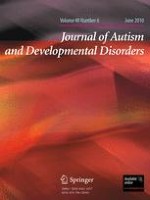01-06-2010 | Original Paper
Variety is Not the Spice of Life for People with Autism Spectrum Disorders: Frequency Ratings of Central, Variable and Inappropriate Aspects of Common Real-life Events
Gepubliceerd in: Journal of Autism and Developmental Disorders | Uitgave 6/2010
Log in om toegang te krijgenAbstract
This study used a novel rating task to investigate whether high-functioning individuals with autism spectrum disorder (ASD) have difficulties distinguishing essential from variable aspects of familiar events. Participants read stories about everyday events and judged how often central, variable, and inappropriate event-components normally occur in this type of situation. The ASD boys made significantly more errors than the typically developing boys in rating the occurrences of variable aspects. In both groups, ratings of variable aspects were age-related, but in the ASD boys, they were also related to theory of mind and weak coherence test scores, and to severity of autistic symptoms. Implications for the understanding of some repetitive behaviours, such as the tendency to adhere to inflexible routines, are discussed.
